Psychedelic arty crashers. From the psychedelic movement there came, inevitably, psychedelic art, and like a great deal else in the movement, it contained much that is old, much that was new, and much that was borrowed and appropriated, especially from the Orient. On the new and futuristic side of the movement were light shows that sent hurtling lights and shifting colors across walls, floor and ceilings. More daring were the multi-media shows and total ”environments” where diverse sensual effects assaulted human brain circuits which the creator’s hoped would vaporize the mind.
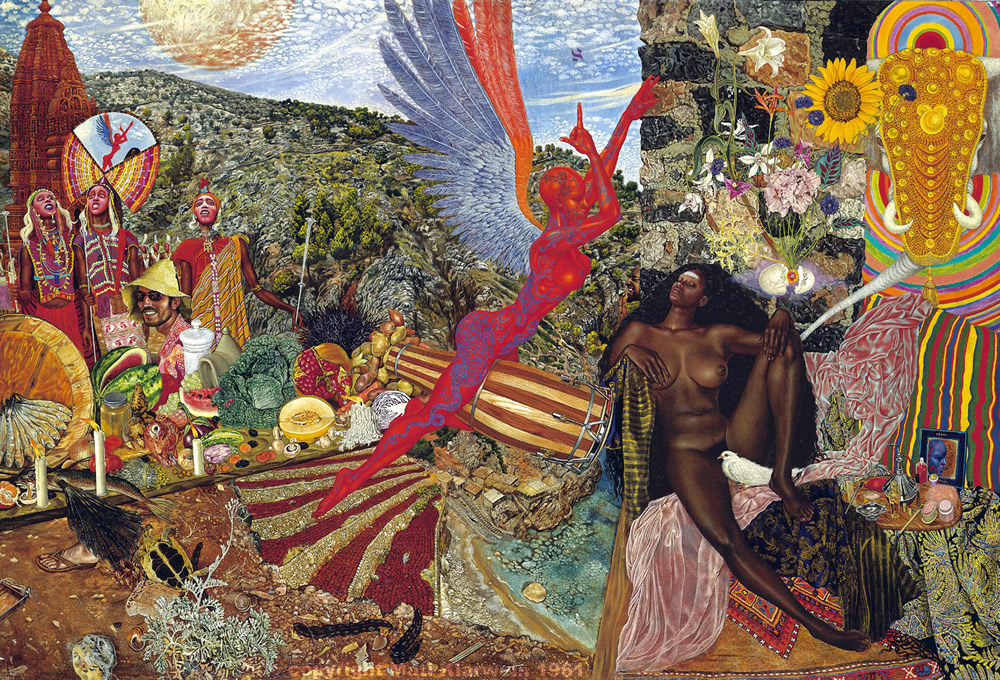
Annunciation, Mati Klarwein, 1961. ( Abraxas )''So they said, "Well, we can't put you in the book." I freaked out, because I wasn't in any book yet (laughter), and I said, "But I get my ideas when I'm high." And they said, "Alright, we'll put you in the book." Next they asked me for the names of other psychedelic painters, and I gave them a whole list, including Fuchs. I called them all up right away, and I told them, "Tell them that you're taking psychedelics!" And they all got in the book. (laughter)''
Psychedelic artists who worked with light were termed lumina artists, a phrase that may have been coined from one of Aldous Huxley’s electrochemical utopias.Psychedelic painting was a curiously old fashioned. in a sense it was the old fashioned landscape painter being brought up to date, and…speed. The intentions were similar though the landscapes were different. The psychedelic painter tried to represent the intense ecstatic superdream in saturated technicolor that they have undergone through the use of a hallucinogenic drug; effectively the inner landscape of the deeper self. Often these painters combined such realism with mystical symbols such as Tibetan mandala, Amerindian iconography and Eastern belief system paraphernalia.
Although Mati Klarwein was considered a psychedelic artist by many, when asked in an interview “How do you feel about being classified as a psychedelic painter?” his response was:I think it’s subjective. Anybody can classify me as they wish. In the fifties I was classified as an illustrator, even though my work consisted of paintings. And in the sixties my work was classified as psychedelic. So I took psychedelics to find out what it was all about. I found out I couldn’t paint on them. I’ll tell you about a funny episode. Jean Houston and Robert Masters put together a book called Psychedelic Art in the sixties, and they came to me. They did an interview with me, like we’re doing now, to include me in their book. And they asked me, “What kind of psychedelics do you take when you’re painting?” And I said, “I don’t take anything when I’m painting. When I take psychedelics I get very horny, and I start going out to nightclubs and cruising.” (laughter)’
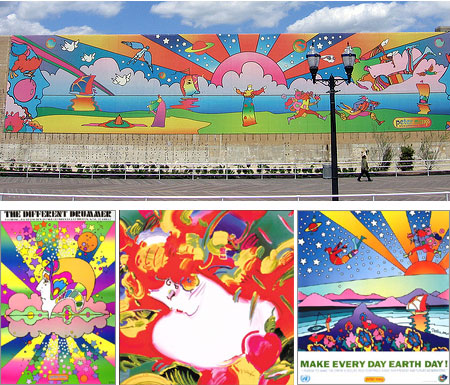
Peter Max took his influences from the underground psychedelic concert posters and album art of the time, and the graphically simplified echoes of that art pioneered by Heinz Edelmann and Milton Glaser, and refined them into a cheerful, less threatening version that became wildly popular.
Most of the psychedelic period art looks somewhat distant, implausible, and a bit repetitive. At the same time, it gives off the faint whiff of a miniature utopia arrested in a drop of amber, inducing a nagging phantom memory of the spontaneity, carelessness, and hedonism of a way of life that probably never had a chance to survive and flourish in an objective geometic society for too long. lLooking at these images communicates this loss and also the loss of a certain delusion. It is important to remember that ‘the Sixties’ seemed a pivotal moment in the history of the Western world where many mistakenly though earnestly believed they were capable with a concerted effort to change the system radically, and durably.
The work of Isaac Abrams seems to represent the default psychedelic style, if there is such thing; it features the flowery organic forms, the curvey fields reminding of sections of fractals from the Mandelbrod set, packed with concentric radiating ornaments, etc.What seems to have dated better is some of the art by Allen Atwell. He is mentioned a few times in Art Kleps book on Millbrook:”Allen Atwell; a professor of art at Cornell. He was preparing for his first “session,” as trips were called in those days, to be held in the tower room, the highest room in the house, that very evening. Allen, who looked like Abraham Lincoln after a hard night anyway, appeared particularly resigned at the time….Novice trippers were heavily “guided” in those days, or, to be more accurate, people, me included, thought they could and should be. It seems reasonable but it isn’t. Ralph Metzner was to “guide” Allen Atwell….How did it go?” I asked….Beautiful, beautiful …” Allan said, putting some coffee on. “But I seem to have switched sides. My left side is now my right side and my right side is my left side….
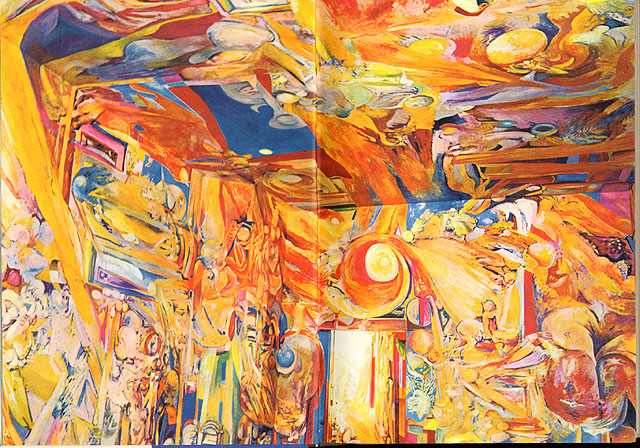
Allen Atwell, Psychedelic Temple. '' to re-create, introduce, stimulate or convey the nature or essence of the psychedelic experience''
…”I liked Allen, but i did not appreciate his pschedelic paintings which mostly looked like interlaced guts to me, and i couldn’t pretend otherwise”.( Art Kelps )In fact, it was this gory quality that distanced Atwell’s work from the kind of psychedelic aesthetics praised by most connoisseurs and self styles experts of the genre who convened to praise art that was bereft of the more severe afflictions of humankind such as the neurotic, the ugly and the debased. ”A regressive aesthetics severely limits the account of Masters and Houston,authors of ”Psychedelic Art” who seem determined to construct “psychedelic art” as novel, noble, positive and transgressive, doing away with the negativity of abstract expressionism and other earlier avantgarde movements. They maintain (without giving any evidence) that ‘the’ psychedelic artist proclaims the long overdue news that F
is dead, and that he refuses to exhibit neuroses or express traumata in his art.”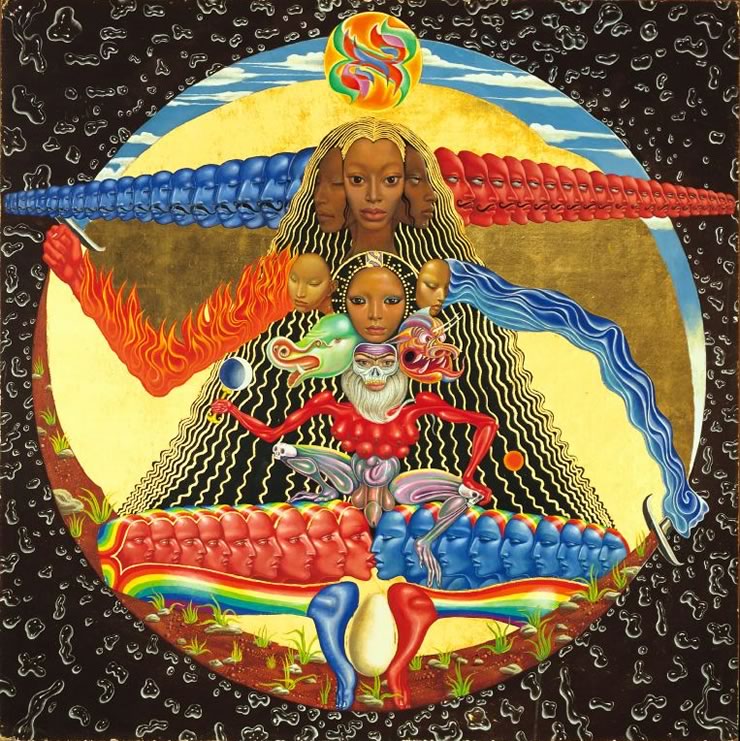
Mati Klarwein, Time, 1965''Although this is the style of art that Mati is best known for, it is also the hardest to classify. Even though these paintings contain many surrealist elements, and Mati was close enough to Salvador Dali to talk about "acting as each other's pimps and cultural spies", Mati would not call himself a surrealist.''
Allen Atwell’s hot molten fantasia of ‘,Psychedelic Temple” was one of the higher points of this art movement. It was spalyed over the walls, ceilings and floor of a Manhatten apartment. Atwell, an art professor at Cornell was not an instant convert to Orientalism. He spent several years, some of the time as a Fullbright scholar, living and studying in India and Southeast Asia. By creating a setting, instead of adorning a wall, Atwell at the time was considered a rebel by breaking with the tradition easel painting in favor environmental painting that returned to an even older tradition that perhaps Michelangelo might have recognized despite the psychedelic guise.
The evils that Aldous Huxley had often warned readers in his works, namely over-population, coercive politics, militarism, mechanization, the destruction of the environment and the worship of science seemed to find their opposites in the gentle and doomed Utopias he created. Aldous Huxley used his books to explore his struggles against personal tragedy and to search for the meaning of human existence. His interest in eastern philosophies and mysticism began in the early twenties with the study of Blake and Bohme. His fascination with eastern religion was one of the reasons he departed on a world tour in 1925 after which his writings reflected different eastern belief systems found in the principles of Buddhism, Taoism, Hinduism and Confucianism mixed with varying doses of mind altering drugs. Aldous Huxley interviewed for the Paris Review (1960 ):
Interviewers: Do you see any relation between the creative process and the use of such drugs as lysergic acid [diethylamide]?Huxley: I don’t think there is any generalization one can make on this. Experience has shown that there’s an enormous variation in the way people respond to lysergic acid. Some people probably could get direct aesthetic inspiration for painting or poetry out of it. Others I don’t think could. For most people it’s an extremely significant experience, and I suppose in an indirect way it could help the creative process. But I don’t think one can sit down and say, “I want to write a magnificent poem, and so I’m going to take lysergic acid [diethylamide].” I don’t think it’s by any means certain that you would get the result you wanted — you might get almost any result.
Interviewers: But the artist’s talents won’t be any different from what they were before he took the drug?Huxley: I don’t see why they should be different. Some experiments have been made to see what painters can do under the influence of the drug, but most of the examples I have seen are very uninteresting. You could never hope to reproduce to the full extent the quite incredible intensity of color that you get under the influence of the drug. Most of the things I have seen are just rather tiresome bits of expressionism, which correspond hardly at all, I would think, to the actual experience. Maybe an immensely gifted artist — someone like Odilon Redon (who probably saw the world like this all the time anyhow) — maybe such a man could profit by the lysergic acid [diethylamide] experience, could use his visions as models, could reproduce on canvas the external world as it is transfigured by the drug.


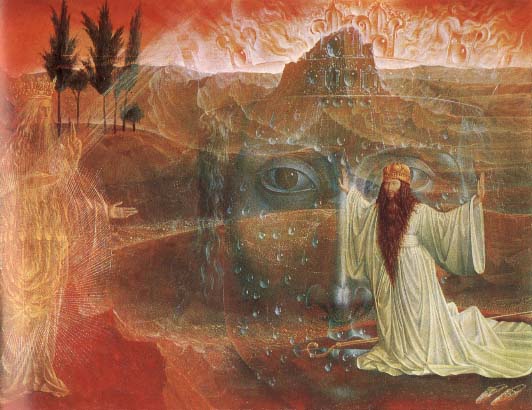
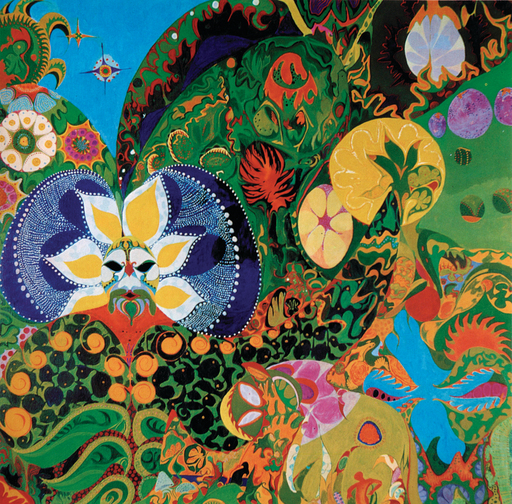



 COMMENTS
COMMENTS
Please take a moment to check out my documentary LSD:POWER & CONTROL.
It features an interview with one of the Divinity Students who was in Tim Leary’s Miracle of Good Friday Experiment.
New Interview with Ram Dass, and a look at LSD and the protest movement…as well as Krassner’s acid trip with Groucho Marx.
posted the film here at Youtube
http://www.youtube.com/watch?v=hZdz0G4lG6k
Thanks for posting this. Very important. I’ve touched a bit on this subject, as a matter of necessary information, but not in any depth as it, though central, lies outside the parameters of the blog as such. Congrats on your work. Am working towards a series on documentary films and the art of making them, but mainly in the food and agriculture sector. But, now you gave me a new lead….so I might contact you soon.